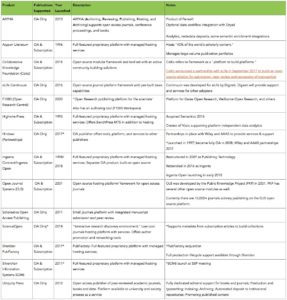Although many societies and associations offer hybrid options within their journals, launching a fully open access journal, or “flipping” an existing journal to fully open access, presents an organization with questions, challenges, and opportunities. The breadth of the decisions to be made cover a wide range of activities from editorial selectiveness to pricing models to process and technology choices, and more.

Focusing in on the technology choices to be made, the landscape that supports publishing overall has seen a lot of change over recent years and now includes increasing variety, as well as solutions specifically designed for open access. As is the case with most partner and technology choices, it comes down to determining the best fit. Does the tool or technology meet our functional needs? Will the solution work within our organizational constraints? Can we afford it? Will our organizational culture mesh with that of the tool or service provider?
When considering the full spectrum of services, support, and technology required to launch an OA journal, the first question to ask is what type of support do you require. That level of support will be determined by your culture, author community, available staffing, experience, funding, risk tolerance, and other factors.
If your organization demands a full service model and does not have the resources to enlist service providers to support that need, you may want to consider a commercial or not-for-profit partner (e.g., university press or society). Publishing partners take much of the responsibility for production, delivery, and supporting services, leaving you to focus on editorial functions. In exchange, you enter into a revenue sharing agreement and you work within the processes and framework of that publisher. Most publishers offer a range of technology choices to support your new journal. Many also work with established industry manuscript tracking and hosting platforms.
If your objective is to self-publish, your technology options are numerous
If your objective is to self-publish, your technology options are numerous. You can build, buy, or do a little of both. This is where options have evolved considerably over the past several years.
- Technology choices have become more modular, meaning that it is possible to build or assemble a solution without starting from ground zero
- Many established technology providers have evolved to offer open access solutions
- Lower cost service and technology providers have emerged that are “open access native.” They cater only to open access and do not carry the technical overhead of subscription requirements
- Open source and solutions based on open source are on the rise. In some cases this is driving down cost, while increasing the pool of resources in the environment that can adapt and extend what has been done by others
The following table represents a sample of the solutions in the market and the technology needs they address. Although this table is not exhaustive, it appears that after significant activity in the late 1990’s, there was a lull in new entrants until the 2010’s, and then increased momentum in the last 5-7 years.

In addition to those listed above, there are several integrators that have reusable components that they employ when creating “build” solutions. GVPi, Ixxus (part of Copyright Clearance Center), and Digirati all have varying degrees of frameworks that enable their clients to benefit from previously completed efforts.
- Platforms built on open source solutions are on the rise. While open source does not mean free, it can mean that there are more affordable and flexible options available either directly (with your own internal development) or through service providers. Collaborative Knowledge Foundation (CoKo) is one example of an organization that is painstakingly building a developer community as well as working with established organizations (e.g., University of California Press) to design and build publishing solutions.
- Modular is in. Large monolithic platforms are becoming a thing of the past. Whether it’s a full-service hosting option that is now offering an array of established partners and integrations, or a hybrid option that you’ve pulled together yourself, best-of-breed is becoming more common. Service providers are clear that they can’t be the best at everything and the technology and integration needs required through the entire publishing life cycle are only expanding.
- New or expanded service providers are surfacing. We are starting to see existing service providers expand their capabilities to encompass more of the publication life cycle (e.g., Sheridan’s acquisition of PubFactory) and existing players in the ecosystem offer new services (e.g., Hindawi’s partnership with AAAS). We expect to see this trend continue. Options like these may present a viable alternative to a commercial publisher while still offering a high level of service and support across the entire publication life cycle.
- Coalitions and co-operatives are being discussed. Fueled in part by the realization of many smaller society and association publishers that they may be more sustainable if they join forces, we expect to see more announcements of societies working together. While the recent launch of the Scientific Society Publisher Alliance (SSPA) focuses on marketing and communications, we expect that publishers will also work together to achieve scale in service and technology procurement.
- Open Access publication has given rise to open access specialists. While market incumbents have expanded their capabilities to support open access, there are a large number of open access service providers, catering to the needs of open access only. These services range from process support, to hosting (e.g., Ubiquity Press, Open Research Central from F1000, eLife Continuum, etc.), to exploring new business models (e.g., KnowledgeUnlatched), to aiding in content discovery (e.g., ScienceOpen). Expect many of these providers to expand their mandate to Open Science and Research.
Publishers have options, even smaller publishers with limited budgets.
Publishers have options, even smaller publishers with limited budgets. Variations in configurations of technology and services are on the rise. API’s make it easier to assemble best-of-breed options for your publishing portfolio, while still enabling search and discovery. When considering hosting options, it is no longer necessary to use one partner or technology for your entire portfolio. You can host your open access content on a born-open access platform, for example, without impacting your subscription content.
Technology can also be secured independently or bundled with services. Options range from publishing partnerships to small open source hosted solutions. But the limited options that we saw in the 2000’s are no longer the case. Competition is increasing. It all becomes a question of understanding your needs and which solutions best align with them.
Discussion
16 Thoughts on "Open Access Technology Options"
There are many options for publishing other than cloning a traditional “journal” model particularly with post publication review. We see the far end of the spectrum here with the “Kitchen”.
Rather than thinking OA either separate or part of the conventional publishing, we are getting back to the core of the value of the traditional publisher. From a production perspective, a number of publishers are demanding, basically, “camera ready” copy from authors. The increase of electronic production vs print (or no print options) and post publication reviews does not eliminate the traditional “impact” factors and other vetting of journals and articles.
With the inevitable shift to service from product (journal), the question of value provided by the traditional publisher, including “marketing”appears increasingly thin. The concern of this within publishing, as also discussed in Kitchen, pushes this within the realm of the near term possible, challenging the current business, pricing, model promulgated early on by Maxwell.
What has been discussed in the emergent “platform” economy is that early entrants become “winner takes all”. The discussion in Kitchen regarding the direction of the largest houses developing such platforms evidenced some concern but more “dismissive”. That may need to be reconsidered.
With the inevitable shift to service from product (journal), the question of value provided by the traditional publisher, including “marketing”appears increasingly thin
Shift? What shift? We’ve long been a service industry. See this from 2012:
https://scholarlykitchen.sspnet.org/2012/05/14/ask-the-chefs-are-we-a-service-industry-or-a-product-industry/
Hi david
Thanks for the link. The exchange is interesting and helpful when it was posted 6 years ago. As we know, digital technologies are rapidly evolving. As I note in my opening statement, there are alternative ways of publishing research other than the “journal” in click or brick form. And I have previously suggested that the “journal” can be considered a “gateway” to getting articles into a database for a variety of uses from post publication review to a user search under various criteria. In that respect, as in the previous post, search/recover/analyze etc in large databases such as Ebsco, for example, can be journal or “gateway” neutral to the end user. It can be “gateway neutral” for the author and even peer review teams.
Thus, current publishers are following what the product platform sector is doing, allowing readers to search across those databases to discover relevant materials regardless of entry point. And this is not limited to author, title, keywords but can include full text search and even extraction. Thus the entry point, the journal, becomes a tag in a search strategy, whether for “editors”, reviewers, or users of published materials. Vetting, or Open Peer reviewed are similarly tags as are OA or paywalled.
As I noted, referring to Gates’ approach, Submission to a “gate”, formally a journal, moves the article rapidly into a database from a preliminary screening. From there, search by various parties makes this accessible.
This makes the 2012 Kitchen exchange interesting from an historic perspective and more like the flipping figure of psychology illusion (e.g. rabbit or duck)
OJS is not a proprietary system, its available under the GNU General Public License. https://github.com/pkp/ojs
I just want to point out a bit of incorrect information – you list in your table that Open Journal Systems is “proprietary” when in fact it is open source. It’s also a lot older than 2013 – while open source solutions may be “on the rise” lately, it’s quite worthwhile to have a look at the success of perhaps the longest-standing participant in this particular area. For more information, please have a look at their website and documentation: https://pkp.sfu.ca/ojs/
Thank you, Lauren. I’ve fixed the source table and will replace the table as soon as I can. As I mentioned above, there was a cut/paste error from the master table (which is much larger!). We had recorded OJS as being launched in 2001 (Conference system was launched in 2000). Most definitely a long-standing solution in this space!
James from PKP here. I think the author is confusing openjournalsystems dot com, which is a third-party OJS service provider (and who does not, to my knowledge, contribute OSS code upstream) with Public Knowledge Project (PKP, https://pkp.sfu.ca), the developers of the open source OJS (and OMP, OCS, OTS …). We are not affiliated with openjournalsystems dot com.
PKP has been around since 1998 as an OA/OSS project, and there are currently 10,000+ journals actively publishing with OJS (map: https://pkp.sfu.ca/ojs/ojs-usage/ojs-map/ and graph: https://pkp.sfu.ca/ojs/ojs-usage/ojs-stats/ (note that 2017 stats are incomplete)). You can also see a brief history of the project here: https://pkp.sfu.ca/about/history/.
Our “SAAS” group, PKP Publishing Services (https://pkpservices.sfu.ca/), alone hosts hundreds of journals and provides support to hundreds of publishers as a hosted service. We also work with publishers and partners to develop and contribute code upstream to the larger OSS platform. One of the more recent examples of this would be our work with UMN Libraries Publishing Services to develop a bepress->OJS migration tool: https://pkp.sfu.ca/2017/12/07/migrating-bepress-digital-commons-journals-to-ojs/.
Happy to provide further clarity if needed.
Thanks James. Both entries were in the master table I used for source (we maintain much larger lists than what is here) and when I created this table and determined to only include OJS, I messed up! It should all be fixed now. I appreciate your input.
Thanks Ann! The update is much appreciated.
Still does not seem correct. Open Journal Systems is open source software, and should be identified as such. PKP has a hosting service (PKP Publishing Services) but the majority of our journals run the open source software themselves.
Nice piece. Here are a few more points about ARPHA:
– Can be used as an end-to-end solution or on a modular basis
– Created with the specific needs of smaller publishers and individual (society) journals in mind
– Two workflows supported – document-based ARPHA-DOC and fully XML-based ARPHA-XML (http://arphahub.com/about/platform)
– ARPHA-XML uses its own WYSIWYG ARPHA Writing Tool
– Industry integrated: http://arphahub.com/about/services#Web-service_integrations
– The platform comes with a range of human- and machine-provided services: http://arphahub.com/about/services
– Publication in PDF, XML and semantically-enhanced HTML
This is a nice listing, but the article does not mention the amount of users for each platform/solution. I mean the article makes a big deal about Coko Foundation, but who is actually using their platform?
Also, I do not see a mention about Janeway (https://github.com/BirkbeckCTP/janeway). I believe that the whole Open Library of Humanities is hosted using Janeway (https://www.openlibhums.org/). Ubiquity does use Janeway, but they also use Open Journal Systems.
Thanks Michael. The point of the article was to provide a sample not an exhaustive list. We do have Janeway on our internal full table. My intention was to show people that they have options, not list all of them – which would get quite long! Also, while open source is not new and PKP has been at this for 20 years, the options are increasing. CoKo was included as one example of that.
Dear Ann,
We saw your post here, d.d. February 22. Thanks for listing us amongst other, your post is a great read, nice to see us of ARPHA in this list! May we add some additional Info about ARPHA here, for everybody’s information:
ARPHA …
• Can be used as an end-to-end solution or on a modular basis
• Has been created with the specific needs of smaller publishers and individual (society) journals in mind
• Does support two workflows: document-based ARPHA-DOC and fully XML-based ARPHA-XML (http://arphahub.com/about/platform)
• ARPHA-XML uses its own WYSIWYG ARPHA Writing Tool
• Is fully industry integrated: http://arphahub.com/about/services#Web-service_integrations
• Does come with a range of human- and machine-provided services: http://arphahub.com/about/services
• Offers publication in PDF, XML and semantically-enhanced HTML
• Offers White-label publishing
best wishes, Dr Matthias Wahls
Business Development Manager ARPHA, Western Europe & Greater Asia



